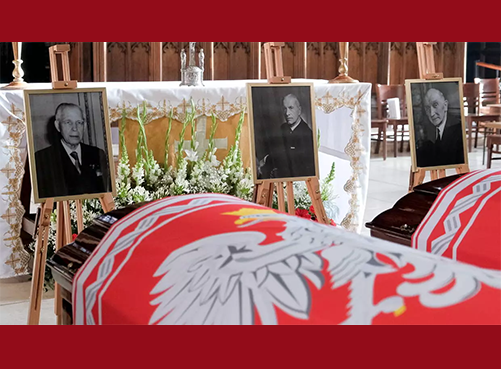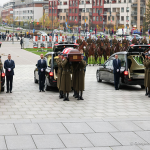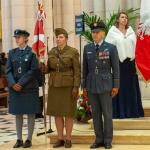The presidents of the Polish Republic in exile – Władysław Raczkiewicz, August Zaleski, and Stanisław Ostrowski – will be buried in the Temple of Divine Providence in Warsaw. Their resting place will be the Mausoleum of the Presidents of the Republic of Poland. The reburial will be attended by President Andrzej Duda and Prime Minister Mateusz Morawiecki.
On Saturday, November 12, 2022, at around 1:00 p.m., a government plane carrying the remains of Polish Presidents Władysław Raczkiewicz, August Zaleski, and Stanisław Ostrowski will land at Warsaw’s military airport. On the tarmac, the coffins will be greeted by the Representative Regiment of the Polish Army, representatives of the authorities, and the clergy.
At 2:00 p.m., the funeral procession will set off for the Temple of Divine Providence in Wilanów. An hour later, a funeral Mass will begin, presided over by Archbishop Stanisław Gądecki, President of the Polish Bishops’ Conference. The sermon will be delivered by the Metropolitan Archbishop of Warsaw, Cardinal Kazimierz Nycz. After the Mass, President Andrzej Duda and Prime Minister Mateusz Morawiecki will give speeches.
At 4:45 p.m. in the Mausoleum of the Presidents of Poland, the coffins will be placed in the sarcophagi, preceded by a salute of honor. The bells of churches throughout the Warsaw metropolis will also ring out.
Immediately after the funeral ceremonies, a Memorial Chamber will be opened to the public, presenting the achievements of the continuators of the Second Republic in exile. The Institute of National Remembrance has prepared the exhibition. “The Chamber of Remembrance serves to recall the figures of the presidents of the Polish Republic in exile, the times in which they had to act, and the challenges they tried to meet,” said Elżbieta Duda, deputy director of the Office of National Education at the IPN, told a press conference at the Divine Providence Centre on Tuesday.
The showcases depicting the figures of the presidents in exile will feature original photographs and documents from the period when they served as heads of state and from their earlier activities. Among the artifacts on display will be memorabilia relating to the last President of the Second Republic, Ignacy Mościcki, the passport and ID card of a health officer from 1944 belonging to Stanisław Ostrowski, the seal of President Kazimierz Sabbat and a gorget donated on September 4, 2004, to Ryszard Kaczorowski on the occasion of his 85th birthday. A special place will be given to a copy of the presidential pennant, which flew over the Royal Castle from 1926 to 1939 and was evacuated with the Polish authorities in September 1939. A multimedia screen will show a film dedicated to all presidents in exile.
The office of the Presidents of the Republic in 1939-90 was held successively by Władysław Raczkiewicz, August Zaleski, Stanisław Ostrowski, Edward Raczyński, Kazimierz Sabbat and Ryszard Kaczorowski. The remains of the first three presidents will be brought to Poland, and they have been laid to rest at the Polish Airmen’s Cemetery in Newark, UK. Prime Minister Władysław Sikorski was also laid to rest in the Newark cemetery until 1993. They will rest in the newly created Mausoleum of the Presidents of the Republic of Poland in Exile at the Temple of Divine Providence. Also buried in the Mausoleum of the Presidents of the Republic of Poland in Exile will be Ryszard Kaczorowski and his wife. They now rest in the Pantheon of Great Poles in the Temple of Divine Providence. There will also be two cenotaphs in the Mausoleum, symbolically commemorating Presidents Edward Raczyński, who died in 1993 and is buried on the family estate in Rogalin, and Kazimierz Sabbat, who, per his family’s wishes, is buried in Gunnersbury Cemetery in London.
The ceremonies at the Temple of Divine Providence mark the culmination of the farewell to the presidents resting in Newark, UK, which took place on November 6th. The cemetery, the largest necropolis of Polish aviators in the UK, was where the first three Polish presidents in exile rested. They were exhumed on November 3rd, but their symbolic graves will remain in the Newark cemetery. As Wojciech Labuda, the Prime Minister’s Plenipotentiary for the Protection of Places of Remembrance, stressed on Tuesday, the funeral at the Temple of Divine Providence will also culminate in the celebrations of the centenary of Poland’s regaining of independence. “We crown it with the burial of three Presidents in exile. The centenary of independence is half a century of Poland outside Poland, of Poland in exile, and today the presidents of that Poland are returning to the homeland,” he stressed.
On November 6th, a Mass for the late Presidents of the Second Republic of Poland was held at Newark’s St Mary Magdalene Parish Church. During an official farewell ceremony at Newark City Hall, the Mayor of Newark-on-Trent received the Guardian of Places of National Remembrance honor awarded by the Minister of Culture and National Heritage for the care of places of national remembrance.
As emphasized by the Foundation “Aid to Poles in the East”, which organizes these ceremonies, the bringing back to Poland of the remains of the Presidents of the Republic of Poland in exile crowns the centenary celebrations of Poland’s regaining of independence. The Polish Government-in-exile was the legal continuation of the system of government of the Second Republic. Under the 1935 Constitution, President Ignacy Mościcki, after his internment in Romania, handed over his office first to Bolesław Wieniawa-Długoszowski and, after his resignation – due to opposition from the governments of France, Great Britain, and General Władysław Sikorski – to Władysław Raczkiewicz, who was sworn in on September 30, 1939. He limited his powers under the so-called ‘Paris Agreement’ with Prime Minister Władysław Sikorski. In June 1940, after the defeat of France, the government moved its headquarters from Angers to London. By July 1945, the Polish Government-in-exile had almost full recognition from the United Nations, apart from the Soviet Union, which broke off relations with Poland in 1943.
President Raczkiewicz held his office until he died in 1947. By his decision, August Zaleski, former Foreign Minister, took over, and after seven years, Zaleski’s term of office was extended indefinitely. Some émigré politicians, including General Władysław Anders and General Bór-Komorowski, formally disobeyed him. On the wave of protests, the Council of Three was formed in 1954 (composed of Gen. Anders, Tomasz Arciszewski, and, after his death, General Tadeusz Bór-Komorowski and Edward Raczyński). Contrary to the Constitution, Zaleski sat in the presidential seat for 25 years. The matter was only resolved after his death in 1972, when his designated successor, Stanisław Ostrowski, was duly recognized.
Following his earlier announcement, he handed over the office of President of Poland to his successor, Edward Raczyński, on April 8, 1979, at the end of his seven-year term. At the age of 88, he assumed the office of President of the Republic of Poland. He held this office until 1986, all the time meeting in London with opposition activists arriving from Poland. Edward Raczyński died on July 30, 1993, in London.
On April 8, 1986, Kazimierz Sabbat was sworn in as President. In his first speech, he stressed that he aimed to preserve the legal continuity of the sovereign Republic based on the 1935 Constitution and the duty to proclaim a full independence program. Given the changes of 1989, it seemed that he would be the last President in exile. He died on July 19, 1989, exactly when Wojciech Jaruzelski was elected President of the People’s Republic of Poland in Warsaw. On the same day, Ryszard Kaczorowski, an exiled scouting activist, was sworn in.
He held the post for only a year and a half. On December 22, 1990, during a ceremony at the Royal Castle in Warsaw, accompanied by the delegate of the government in exile to Germany, Wincenty Broniwój-Orliński, Kaczorowski handed over the insignia of power, including the Order of the White Eagle, to the first freely elected President, Lech Wałęsa.
The decision to hand over the presidential insignia to Wałęsa was highly controversial. The émigré circles approached the Round Table arrangements with distrust. Kaczorowski left London for a shrine in Lourdes, France, and there decided for his to travel to Warsaw. In the years that followed, he was a symbol of the continuity of Polish statehood. He was laid to rest in the Temple of Divine Providence as “the last President of the Second Republic”.
The intention to bring the remains of the three presidents of the Second Republic in exile to Poland was announced on October 30th by Prime Minister Mateusz Morawiecki. “The ceremonial burial at the Temple of Divine Providence will be a symbolic closure of their forced exile,” Prime Minister Mateusz Morawiecki said in his podcast. He described the Presidents-in-Exile as “depositors of Polish sovereignty who carried hope to Poles scattered around the world, but also to compatriots who resisted communism at home in various ways”. He stressed that they aimed to ensure the continuity of independent Polish statehood.
The initiative to bury the remains of the Presidents of the Second Republic of Poland in the Temple of Divine Providence is being carried out by the Foundation “Aid to Poles in the East” in cooperation with the Chancellery of the Prime Minister, the Institute of National Remembrance, the Divine Providence Centre, the Ministry of National Defense, the Ministry of Foreign Affairs and the Office of the “Niepodległa” Programme. (PAP)
Author: Michał Szukała
The three presidents of the Republic of Poland in exile came from the generation that fought for an independent Poland during their youth and then, in the inter-war period, built an independent country, historian Prof. Marek Wierzbicki from the IPN’s Delegation in Radom office tells the Polish Press Agency PAP.
Polish Press Agency: Władysław Raczkiewicz was President when it became clear that the Polish government would not return to a liberated Poland, as the country was under Soviet occupation. How did he see his further mission and the continuation of a government deprived of its own state?
Prof. Marek Wierzbicki: The end of the Second World War and the decision of the Big Three to place Poland in the Soviet sphere of influence resulted in the decision by the Polish authorities in exile to remain in exile. It was recognized that there was no possibility of conducting independence activities in the homeland and that a Polish state should be created in exile.
Polish elites recreated many institutions of the Polish state, including the government and parliament. Poland outside its borders was also to be built by around half a million Poles, who decided not to return to a country ruled by the communists and to create a nation in exile. In a sense, this was the Second Republic – rescued and transferred to a different political and geographical reality. Let us remember that, in addition to state institutions, hundreds of social, cultural, and political organizations of all kinds were created that had a Polish character. This is an amazing example of the continuation of independent thought and the functioning of our state.
PAP: In the shadow of his predecessor, who had held the post since September 1939, is his immediate successor August Zaleski. During his presidency, many divisions and conflicts emerged within the Polish exile, affecting the position of the President and the government. What were the reasons for this decline in the importance of Poland in exile?
Prof. Marek Wierzbicki: August Zaleski went down in memory of the Polish émigrés as a president during whose rule there was a deep split in the circle of Polish political refugees. Shortly before he died in 1947, President Raczkiewicz changed his decision. Initially, his successor was to be Prime Minister of the Polish Government Tomasz Arciszewski of the PPS, but he eventually chose former Foreign Minister August Zaleski. This was a violation of the agreements between the main political forces. This decision caused a deep division among Polish émigrés who wanted to continue the mission of sustaining the institutions of the Second Republic abroad.
It seemed that in 1954 the two conflicting currents of Polish emigration would reach a consensus on the matter and end the dispute destroying the cohesion and authority of the state in exile. The main negotiator of the agreement between Zaleski and his opponents was General Kazimierz Sosnkowski. The President stated that he would accept the agreement to resign and hand over the function of President to Sosnkowski. Soon after signing such an agreement, however, he announced his withdrawal from the Act of National Unity provisions, which deepened the divisions. A minority of exiles remained around the ‘Castle Camp’ headed by President Zaleski. Greater authority was enjoyed by the Council of Three, chaired by General Władysław Anders, Tomasz Arciszewski, and Edward Raczyński. Only after the death of President Zaleski in 1972 was reconciliation possible, but the conflict proved devastating for the Polish exile. Zaleski decided to extend his term of office. He held the office for 25 years. He reasoned that this was the best solution for the Polish raison d’état and that, with a sense of responsibility for the state, he could not resign his office.
PAP: His successor, Stanisław Ostrowski, was sworn in in 1972, when the generation symbolized by, among others, General Anders, who had died two years earlier, was passing away. What was the position of the new President under these circumstances?
Prof. Marek Wierzbicki: The first half of the 1970s was a period of deepening crisis in Polish emigration. After the Millennium celebrations in 1966, divisions among the Polish exile were strengthening. The support of the younger generation, which had grown up in Britain and other countries of the world, assimilating more and more strongly into the societies of the countries of settlement, was diminishing. Stanisław Ostrowski, therefore, did not have as much authority among Polish émigrés as his predecessors. He was, however, credited with reconciling the feuding currents, which in 1973 established cooperation by forming a joint government. As a result, President Ostrowski led the entire independence camp until the end of his term.
The situation of Polish emigration began to change for the better in 1976, with the emergence of organized anti-communist opposition in Poland. The election of Karol Wojtyła to the papal throne in 1978 and the creation of Solidarity in 1980 also provided a huge impetus for the revival of Polish emigration. The Polish political emigration became the spokesperson of the “Solidarity” movement abroad and represented the whole nation fighting against communism. There was also a growing interest in world public opinion in the Polish independence emigration, which had been experiencing a revival since the end of Ostrowski’s term.
PAP: It is most often mentioned that the task of the presidents of the Polish Republic in exile was to preserve the symbols of the Second Republic. Other tasks they performed are less often remembered. What initiatives did the presidents of the Republic of Poland in exile undertake beyond their symbolic function?
Prof. Marek Wierzbicki: They possessed authority and power, assured by the April Constitution, which – although in the conditions of separation from the country, it had a limited and largely symbolic character – gave the Presidents of the Second Republic enormous powers. The government in charge of various Polish institutions in exile operated under the President’s control. Various institutions and social, political, and cultural organizations were also subordinate to him. One of these was the National Treasury, which, through its structures in many countries around the world, collected funds for the activities of the Polish Government. These contributions made it possible for Polish institutions to function modestly, as well as schools and scouting, among others. Still, they ensured that they remained independent and autonomous from foreign political centers. All these institutions also educated in a patriotic spirit and took great care to preserve the Polish language and knowledge of Polish history. These activities maintained Polish national identity and an awareness of the independence mission of political exile.
PAP: A feature uniting the first three presidents of the Second Republic in exile is that they held important political posts already in the inter-war period. What other features did Raczkiewicz, Zaleski, and Ostrowski have in common?
Prof. Marek Wierzbicki: They came from a generation that had fought for an independent Poland during their youth and then built an independent country in the inter-war period. They received a very strong patriotic upbringing, and it was patriotism that they shared. They were also united by an awareness of the Polish raison d’état. They understood the critical role of the state, even if it functioned in exile. Its existence and the safekeeping of the insignia of power were of colossal importance for the preservation of the tradition of Polish sovereignty.
I think that focusing on concern for the Polish state and its continuity of functioning and even symbolic activity in exile helped to give direction to their political action and made the emigration realize that the overriding goal was to rebuild an independent Polish state. The independence regained in 1918 determined the fate of successive generations of Poles throughout the 20th century, and emigration was the continuation of the independent Polish state – the Second Republic and Polish political thought, which placed the existence of statehood as a necessary condition for the survival and development of the Polish nation.
Interviewed by Michał Szukała
Translation: J. Czarniecki
…..



